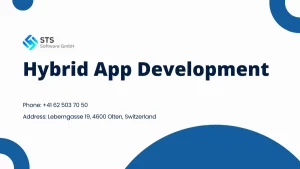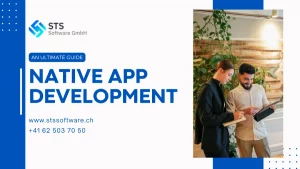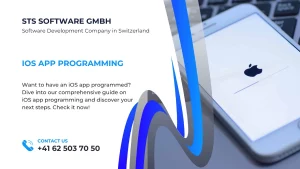Agile software development has demonstrated substantial success in the software development industry, with 39% of users reporting higher project performance rates compared to other methods. Nearly three out of five Agile users are satisfied because their software product can better align with their business needs.
So, what is Agile software development? This article will dig into the fundamentals of Agile software development methodology to explain how it enhances project flexibility and customer satisfaction. Let’s jump right in!
The Evolution of Software Development
Businesses manage and execute their software development projects differently depending on their needs. Waterfall used to be the most popular solution, but many companies have switched to Agile methodologies.
Waterfall Method
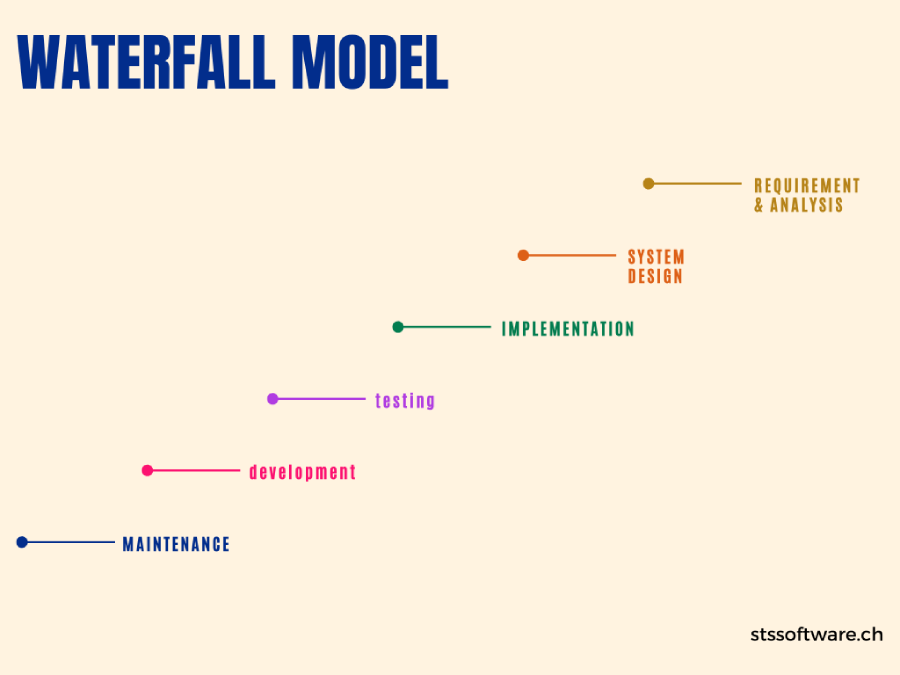
The waterfall method is a traditional software project management approach. It follows a linear, sequential process called the Software Development Lifecycle (SDLC). In this manner, each phase is completed before the next one begins.
The waterfall software development offers several advantages, such as:
- Clarity: The linear structure ensures disciplined progress through project phases.
- Management: Clear milestones allow for easy management.
- Team collaboration: Large teams can work on a common goal as defined in the beginning.
- Simplicity: The straightforward methodology makes it easy to follow and implement.
Despite its benefits, the limitations of waterfall method give businesses a hard time running their projects. For example, this method doesn’t easily accommodate changes once a phase is completed. The inability to work on different phases simultaneously can reduce efficiency. Due to the lack of adaptability, this method is not ideal for complex projects.
Emergence of Agile
Agile methodologies emerge as a direct response to the limitations of the waterfall method. The Agile concept involves breaking a software development project into different phases and focuses on continuous improvement and collaboration.
In waterfall, testing is only implemented until the end of the development process. Meanwhile, developers can continuously test the product using the Agile method to ensure the best outcome.
Additionally, waterfall projects often take longer because the development team has to agree on the project requirements before starting, whereas Agile projects work on iterative development cycles that speed up the process.
What is Agile Software Development?
What is Agile software development? Agile is a software development methodology that highlights the importance of continuous releases according to customer feedback. The ability to modify the product in every iteration maximizes flexibility and velocity.
The Agile Manifesto reveals the four values and twelve principles of Agile software development methodology:
Four Values
Agile highlights four values during the software development process:
- Individuals and Interactions over Processes and Tools: Agile values people and their interaction during the process. The development team responds well to business needs and prioritizes customer satisfaction.
- Working Software over Thorough Documentation: Agle doesn’t eliminate documentation completely but aims to streamline this process to enhance productivity and reduce delays.
- Collaboration over Contract Negotiations: Agile also highlights continuous collaboration with customers throughout the development process so the team can understand their customers better.
- Responding to changes over Sticking to the Plan: Short iterations and flexible planning are the core of Agile, ensuring the team can adapt quickly to new requirements.
Twelve Principles
The Agile Manifesto outlines 12 principles as follows:
- Ensuring customer satisfaction by delivering valuable work continuously.
- Dividing large tasks into manageable pieces.
- Valuing the self-organized teams for the best results.
- Offering motivated team members with the best support and environment.
- Developing processes that encourage sustainable efforts.
- Maintaining a consistent pace for the project.
- Sticking to changing requirements, even late in the project.
- Holding regular meetings so team members can be on the same page.
- Having the team reflect on the progress and adjust the plan accordingly.
- Measuring progress by the amount of completed work.
- Seeking continuous excellence.
- Use the changes as competitive advantages.
Core Principles of Agile
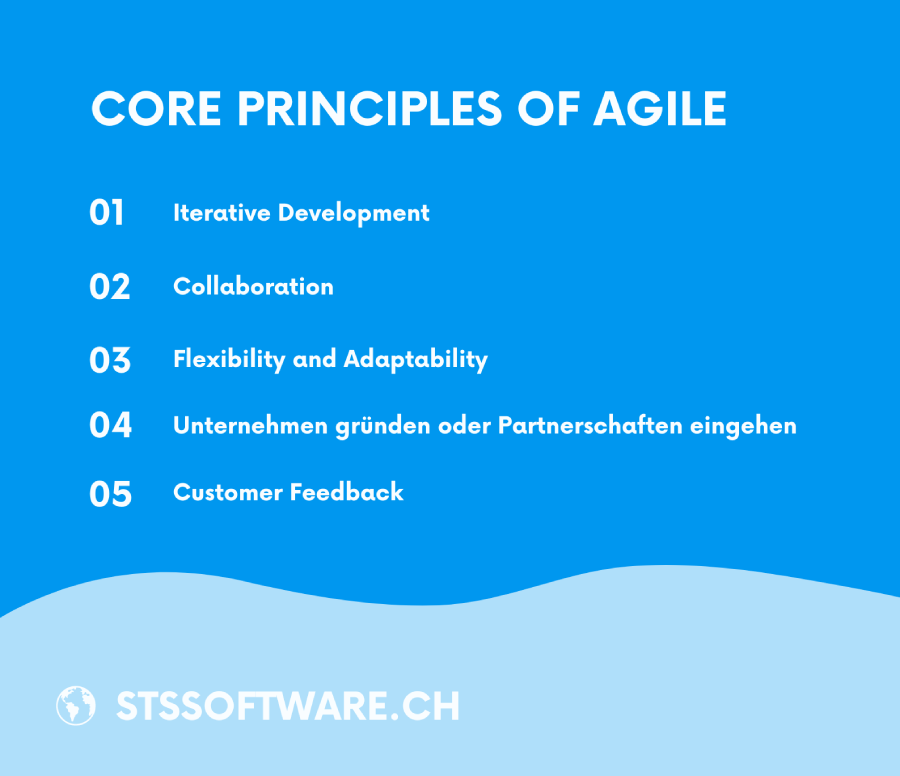
Agile focuses on iterative development, teamwork, flexibility, and customer feedback. All these concepts promote an adaptive approach that meets the evolving needs of stakeholders and customers.
Iterative Development
Agile software development emphasizes the creation of software in small, manageable parts, each lasting a few weeks and focusing on specific features of the software. This method allows regular feedback to ensure the software satisfies changing user needs and market demands.
Collaboration
Collaboration is another core principle of Agile software development methods, focusing on close cooperation between cross-functional teams and stakeholders.
A software development team comprises developers, testers, designers, business analysts, and project managers. Each member of the team plays a vital role in the development process. Collaboration between these experts enables quick adjustments so the product aligns with user needs.
Flexibility and Adaptability
Unlike traditional methods, Agile development focuses on evolving requirements based on feedback. The high level of adaptability guarantees the final product remains relevant.
For example, in Agile development, when the team receives any feedback from stakeholders, they hold meetings to review the current progress and dedicate the next iterations to fixing the mistake.
Customer Feedback
In Agile methodologies, customers are at the center of the development cycles. Agile teams gather insights from their target audience and prioritize their favorite features when building the software.
Moreover, the team keeps collecting customer feedback to enhance product quality and user satisfaction. This approach ensures that the final product exceeds user expectations.
Agile Methodologies
Agile is a diverse methodology with many variations, each with distinct focuses, processes, and advantages.
Scrum
Scrum is a popular framework within the Agile methodology in software engineering. This method emphasizes iterative progress through sprint, usually lasting two to four weeks.
There are three roles in Scrum:
- The product owner defines the product backlog to ensure the team works on tasks that deliver the highest value.
- The Scrum master guarantees that the team sticks to Scrum practices.
- The development team delivers product increments at the end of each sprint.
The Scrum process starts with creating a product backlog and summarizing it at the end of each sprint before moving to the next one. The process includes four ceremonies as follows:
- Sprint planning: This step involves creating a product backlog, a list of work written based on the product requirements and roadmap.
- Daily stand-up: The team holds daily meetings to discuss the progress.
- Sprint review: At the end of the sprint, the team collects feedback from stakeholders, product owners, and customers.
- Sprint retrospective: The team evaluates the sprint to modify it before planning for the next sprint.
The whole Agile Scrum methodology aligns well with SDLC methodologies to ensure continuous improvement and delivery of high-quality software.
Kanban
Kanban is an Agile software development methodology originating from lean manufacturing, started by Toyota. It works as an extensive to-do list that helps manage a software development project by priority. There are four principles in Kanban:
- Visualize work: In Kanban, the development team visualizes their tasks as cards on a board. They represent process stages (Not Started, Development, Testing, Done) by columns. As the project progresses, they move the tasks through these stages.
- Limit work in progress (WIP): Kanban aims to limit the number of tasks, often two to three, to prevent overloading and ensure the ultimate focus on each task.
- Pulling over pushing: Team members pull their tasks from the board when they are ready for more work to avoid bottlenecks.
- Monitor and Improve: The team often uses visual tools to understand work progress and identify areas for improvement.
Lean
Lean focuses on efficiency by identifying and eliminating waste. The five Lean principles below guide the team through a structured process to deliver high-quality products and optimize workflow:
- Identify value: The team learns customer needs to determine the end goals that provide satisfaction.
- Map the steps: Then, they map out the steps needed to run the project. If a step doesn’t contribute to continuous delivery, it will be eliminated so the team can focus on activities that add value.
- Create a flow: After cutting the unnecessary steps, the team checks if the remaining process works efficiently to establish a smooth workflow.
- Introduce a pull system: The team implements a system where they create products based on customer demand and WIP items. This way, only necessary items are done.
- Seek perfection: Lean methodology also aims to continuously improve the process by refining the steps.
XP (Extreme Programming)
XP is designed to improve software quality with frequent releases in short development cycles. It emphasizes the relationship between customers, stakeholders, and the development team. Some popular XP practices businesses can try are:
- Pair Programming: In this approach, two developers work together, with one coding and one reviewing the code. They may sometimes switch roles to enhance code quality through collaboration and continuous review.
- Test-Driven Development (TDD): In TDD, developers build test cases before coding to ensure their code is tested continuously.
- Incremental Development: XP plans to develop software in small increments and deliver new features every few days. This method encourages continuous customer feedback so the final product meets specific user needs.
- Daily Design: Developers work on the design daily to maintain high-quality software architecture.
- Integration Testing: The development team performs integration tests several times daily to identify bugs and ensure that different software components work well together.
Benefits of Agile
Agile development methods offer numerous benefits regarding software quality, customer satisfaction, speed, and collaboration.
Improved Quality
Iterative testing and continuous feedback loops are the core values of Agile development. In this manner, each iteration includes rigorous testing so developers can identify and resolve defects promptly. Due to the lower risks of errors, the software can be of higher quality.
Regular feedback also ensures that the product meets the needs of stakeholders and customers. The ongoing interaction between the development team allows for quick enhancements, leading to a user-centric product.
Customer Satisfaction
Customer involvement is the cornerstone of Agile programming. Through the Agile development model, customers are engaged in the development process, providing feedback and input at every iteration.
The Agile methodology software also emphasizes adaptability. Whenever the development team receives feedback, they start working on the project immediately to ensure the product truly addresses user requirements.
Faster Time to Market
Agile methodologies aim to speed up the software development process. The iterative nature of the Agile model ensures that new features and updates can be handled regularly, keeping the product responsive to market demands.
Team Morale
Agile teams are self-managing. Hence, they have more authority over any decisions in the project. This high degree of control fosters ownership and responsibility to boost productivity.
The project manager safeguards the team from external interference so they can focus on their tasks. They can even learn new skills and thrive in their roles.
Challenges and Misconceptions
Businesses need to understand the challenges and misconceptions to improve their Agile practices effectively.
Common Challenges
Agile development methods have outstanding benefits but still come with challenges related to continuous changes and misalignment with business culture.
- Resistance to change: The changes during development cycles may make developers feel insecure and worry that the updates disrupt or increase tier work. Businesses need open communication to solve this problem.
- Misalignment with organizational culture: Agile development highlights collocation and continuous improvement, which may conflict with the existing system of some companies. Project managers should encourage transparency to deal with this issue well.
- Scaling in large organizations: Agile works perfectly for small teams. Meanwhile, large organizations need a robust framework to align with their objectives.
Misconceptions
A common misconception is that Agile is ad hoc and has no structure or process control. Yet, Agile programming provides various methodologies like Kanban and Scrum that have well-defined practices to ensure process control and continuous improvement.
Another misconception is that Agile methodologies eliminate the need for documentation, but it’s not true. In fact, their “Just In Time” documentation focuses on creating documentation that is really valuable and necessary.
Agile in Practice
Agile is now widely used in various industries. Businesses must choose the best practices to succeed with their software development projects.
Case Studies
SKY, a famous broadband, satellite TV, and telephone service brand, transitioned its old projects to Agile methodology software. This shift was challenging at first because the company had to make substantial changes in its perspectives and attitudes toward familiar processes. However, the benefits were outstanding: their software was built more quickly and released more often, enhancing their ability to adapt to market demands.
The automotive giant Bosch experienced a positive change, too. In 2018, the company employed Scrum development teams, spreading agility across the staff. Leadership was crucial for the success of Bosch’s transformation to Agile software development with Scrum. The leaders prioritized the backlog and engaged in conversations that enable fast feedback and collaboration.
The two cases above demonstrate how Agile and offshore development strategies can significantly improve software development processes. Businesses can use them to drive better alignment with market demands and enhance overall efficiency.
Best Practices
Organizations can adopt and scale Agile methodologies to experience more efficient processes and high-quality products. The best practices include:
- Building projects with motivated staff
- Encouraging face-to-face communication
- Forming self-organized teams
- Prioritizing the product backlog to ensure the most important tasks are handled first
- Regularly reflecting on team processes
- Using charts to track progress visually
- Designing an ideal workspace that the team enjoys working in
Conclusion
You have found the ultimate answer to “What is Agile software development?” Basically, Agile software development stands out for its iterative approach, collaboration, and flexibility to ensure your project can meet changing needs.
Share your Agile experiences or reach out to us to implement Agile in your software development projects successfully!

